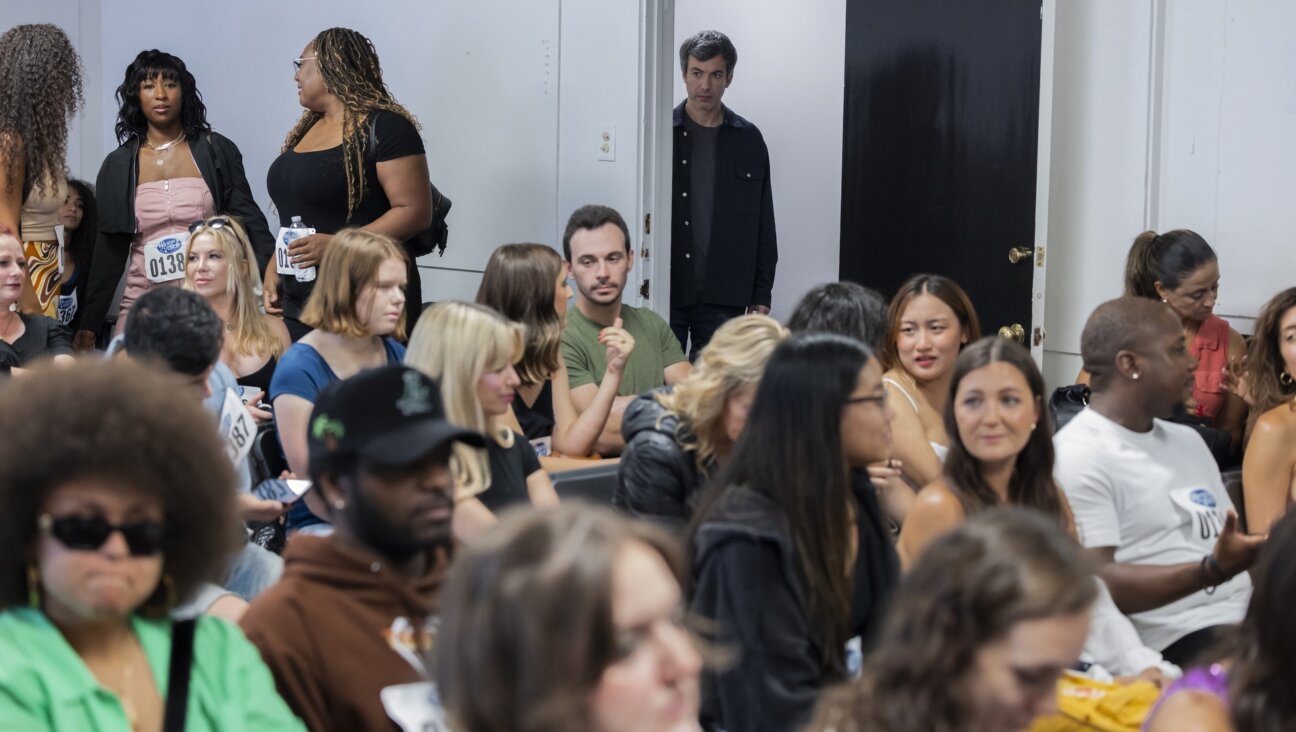Core Connection

Tours That Bind: Diaspora, Pilgrimage and Israeli Birthright Tourism
By Shaul Kelner
New York University Press, 304 pages, $35

Shaul Kelner’s book is auspiciously timed, with discussion still swirling about American Jewish attitudes toward Israel. While much is contested about Peter Beinart’s controversial essay, there is agreement that a sizable proportion of young people, especially among the non-Orthodox, are disengaged from Israel: what the proportion is, who they are, whether the proportion is increasing and whether it is part of a more general disaffection from Jewish involvement or specific to Israel are all in dispute. These disaffected Jews are, however, precisely the target population of Taglit-Birthright Israel, the program that funds Israel-experience trips for young adults and is the focus of Kelner’s “Tours that Bind: Diaspora, Pilgrimage and Israeli Birthright Tourism.”
Kelner has intimate knowledge of Birthright, having gone on three separate trips as a “participant observer,” written his doctoral dissertation on it and participated in its evaluations while at the Cohen Center for Modern Jewish Studies, at Brandeis University. So, I expected the book to be a definitive evaluation of the program. But while Kelner does use existing research to discuss how well the tours have worked, he’s more interested in how they manage to “bind” their tourists — and what they manage to “bind” them to.
As a quantitative sociologist, I rely on many cases to make me feel comfortable with the conclusions of research. Yet Kelner gives a supreme example of how a case study can be successful. Drawing mainly on his own participant-observation experiences, Kelner situates the program in a context of political tourism, giving us new tools with which to understand the visceral, emotional and cognitive impacts on the participants. This provides a sophisticated lens through which to analyze what the Birthright program, and others like it, does, how it accomplishes its goals, what those goals are and why the mechanisms used may also limit its impact.
As Kelner describes how the program is experienced through the participants’ own words, I couldn’t help but compare this to my own first experience of Israel. I was one of seven high school representatives of U.S. Girl Scouts to the International Scout Jamboree; only two of us were Jewish. I knew at the time that I would have the privilege of a different window onto Israel than I would have had with a Jewish youth or synagogue group (as my sister had). Indeed, I visited many of the Christian sights the Birthright participants don’t; I mingled with Israeli Druze and Arabs through the jamboree, and spent 10 days as an international visitor worker on a kibbutz.
Unlike the Birthright participants, I had very little exposure to any Israeli telling me I had come “home,” little prodding from my leaders or peers to re-examine my Jewish or Diaspora identity, and little exposure to the political forces of the day (especially as they were much less imminently pressing in the mid-1960s than they are today). And yet, Israel worked its wonder on me and touched a core of my Jewish identity and pride that was, as it were, life-changing. With the tools in Kelner’s book, I can look back to that experience and analyze how and why this effect was realized, what role I played in it as agent, and what role others’ agency and structure played in it. I would thus recommend the book to anyone who has made a “first visit” to Israel (or anywhere else as a “political tourist”), because of the insight it offers.
With typical ethnocentrism, Jews may be surprised to learn that they are not the only diasporic people who have engaged in “political tourism” to the homeland. Drawing on research from Taiwan, China, South Korea, Africa, India, and Central and Eastern Europe, Kelner provides a refreshingly broader spectrum of comparison for Israel-experience tours. He also summarizes the background of these tours as they began and developed, utilizing the Israeli educational tiyul (literally, hiking, but also used more broadly as a “ritualized sanctification of space”) for forging personal ties to the land, bringing us to the current Birthright program.
Appropriately for the amount of money spent on them, these programs are highly developed. Exploring the guidelines and implementation of the program as he observes it firsthand, Kelner reveals the ongoing and vital importance of the interaction between guides and tourists. Neither group is just a passive pawn of the system. Through detailed narrative examples, he shows how both verbal and nonverbal factors affect political understandings, and how questions, joking behavior and actions of the particular tourist group affect implementation of any intentional messages.
Kelner explains why there is no monolithic shaping of attitudes about the Arab-Israeli conflict and why there could not be, even if that were the intent of the forces behind the program. J Street may be rooted in the experiences of some of Birthright’s participants, just as the American Israel Public Affairs Committee may get its support from others. As Kelner points out, on the other hand, by exploring in-depth the multifaceted nature of Israeli society without doing the same for Palestinian or Arab society, the tours do, in fact, shape the pro-Zionist emotional impact of the political socialization. Israeli culture is presented and Diaspora living is not disparaged, allowing for a blossoming of Jewish identity that carries over beyond the tours themselves.
With Kelner, we accompany groups as they experience the climb to Masada, the entrance to Jerusalem, their encounter with Yad Vashem and Mount Herzl, and their visits to Tel Aviv, Safed and the Dead Sea, and see how they “consume place” through symbols, products and commodified experiences, imbuing the tourist places with meaning, and how by doing so, they become aware of the public, collective, embattled, empowered and consequential nature of Jewishness in Israel. “Doing Jewish” becomes part and parcel of the participants’ way of life — while in Israel, to be sure, but also, for many after they return home.
Kelner also shows us that the very nature of tourism distances the participants from Israel. From the border-control entry, to the temporary nature of the sojourn, to the consciousness of tourists being the “other” when they meet “native” Israelis, tourism structures a distance between the Diaspora inhabitant and the homeland. By encouraging the participants to face this in open discussion, structuring communal encounters with place and reinforcing normative goals, tour guides and staff provide opportunities for multilevels of experience that touch emotion, identity and cognition.
But be forewarned: Readers looking for a simple answer to “Are these tours successful?” won’t find it here. This is not a simple book, nor a particularly fast read. You have to think about what Kelner writes. In his sophisticated discussion, Kelner suggests that there are no clear recipes for increasing that elusive attachment to Israel or for strengthening (diasporic) Jewish identity, though both are official goals of the program. As Kelner writes, “Rather than providing an answer to the question of home, the tours open the question further and introduce new dimensions of complexity that may not previously have been experienced or recognized.”
What Kelner does is show us just how much goes into the “performance” of the Israel experience, and why this experience has such potential for making an impact on its participants’ lives. No participant will come away from the Birthright experience untouched, and many, indeed, find it life-changing.
Harriet Hartman is a professor of sociology at Rowan University, president of the Association for the Social Scientific Study of Jewry and Berman summer research fellow at the North American Jewish Data Bank. With co-author Moshe Hartman, her most recent book is “Gender and American Jews: Patterns in Work, Education, & Family in Contemporary Life” (UPNE/Brandeis University Press, 2009).
The Forward is free to read, but it isn’t free to produce

I hope you appreciated this article. Before you go, I’d like to ask you to please support the Forward.
Now more than ever, American Jews need independent news they can trust, with reporting driven by truth, not ideology. We serve you, not any ideological agenda.
At a time when other newsrooms are closing or cutting back, the Forward has removed its paywall and invested additional resources to report on the ground from Israel and around the U.S. on the impact of the war, rising antisemitism and polarized discourse.
This is a great time to support independent Jewish journalism you rely on. Make a Passover gift today!
— Rachel Fishman Feddersen, Publisher and CEO
Most Popular
- 1

News Student protesters being deported are not ‘martyrs and heroes,’ says former antisemitism envoy
- 2

Opinion My Jewish moms group ousted me because I work for J Street. Is this what communal life has come to?
- 3

News Who is Alan Garber, the Jewish Harvard president who stood up to Trump over antisemitism?
- 4

Fast Forward Suspected arsonist intended to beat Gov. Josh Shapiro with a sledgehammer, investigators say
In Case You Missed It
-

Culture ‘Shtisel’ star Sasson Gabay is happy to be back playing a complex haredi Orthodox Jew in ‘Kugel’
-

Fast Forward Noa Argamani, ADL’s Jonathan Greenblatt among over a dozen Jews on 2025 TIME 100 list
-

Fast Forward US claims Mohsen Mahdawi’s activism could ‘potentially undermine’ prospect of peace in Gaza
-

Opinion What Jewish university presidents say: Trump is exploiting campus antisemitism, not fighting it
-
Shop the Forward Store
100% of profits support our journalism
Republish This Story
Please read before republishing
We’re happy to make this story available to republish for free, unless it originated with JTA, Haaretz or another publication (as indicated on the article) and as long as you follow our guidelines.
You must comply with the following:
- Credit the Forward
- Retain our pixel
- Preserve our canonical link in Google search
- Add a noindex tag in Google search
See our full guidelines for more information, and this guide for detail about canonical URLs.
To republish, copy the HTML by clicking on the yellow button to the right; it includes our tracking pixel, all paragraph styles and hyperlinks, the author byline and credit to the Forward. It does not include images; to avoid copyright violations, you must add them manually, following our guidelines. Please email us at [email protected], subject line “republish,” with any questions or to let us know what stories you’re picking up.












